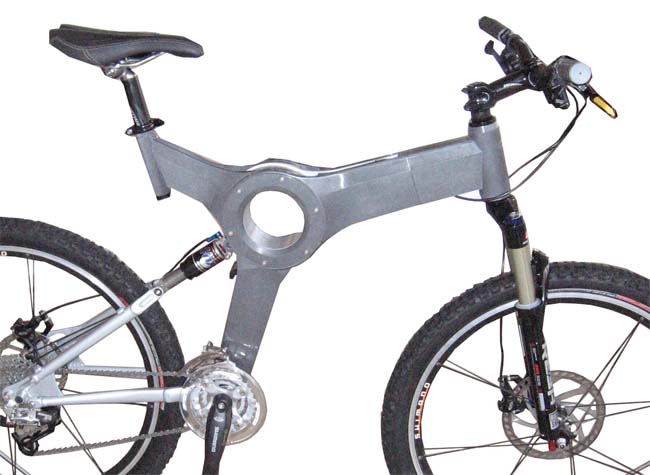Full-Scale Folding Bike Built on Solido SD300
Rapid Tech that Will Change the World, Honorable Mention: Working model created by Ziv-Av Engineering for demo wins investment funding.
Latest News
December 1, 2009
By Pamela J. Waterman
No one is sure who invented the bicycle, but by 1893 an American was issued a patent for a folding two-wheeler design and in 1896 a French military version followed suit. During World Wars I and II, thousands of British military folding bikes were in use, and now more than a hundred manufacturers produce their own interpretations.
 The three main sections of this folding bike were built on a Solido 3D SD300 desktop printer and painted to look like metal. |
Folding bikes fill a growing need for transportation options beyond traditional designs. With a frame that generally doubles up on itself, folding bikes fit in the trunk of most cars and behave like a piece of luggage on a bus or subway, in an office, dorm, or apartment. In spite of the competitive market, there’s always a drive toward less weight and better handling.
This new folding bicycle concept first saw the light of day on an Israeli reality-TV show based on Japan’s “Dragons Den” investment concept. The program matches up inventions with investors and in Israel goes by the undeniably striking name of “The Sharks.” Would-be inventors get four to five minutes to present their product’s concept and business plan before getting the thumbs up or down for funding.
Traditionally such bicycles fold in half like a book closing, with the front wheel swung to right or left to meet the rear tire. The key to this new design is a central pivot structure. Here the front wheel swings up and back toward the rear section more like folding a classic Swiss Army knife for a more compact profile. For the show, the company needed a full-size working bicycle tough enough to be put through its paces.
An Israeli product development company, Ziv-Av, took on the job and selected the Solido 3D SD300 printer to create quick but durable parts from layered sheets of SolidVC, a rigid PVC-based material that can be machined, painted, and finished.
The inventors tasked Ziv-Av with building the three main sections of the bike frame plus the folding mechanism. Engineers broke down the frame design into six parts comprising 14 total pieces. At 22 inches long, the top tube was the largest final part. The folding mechanism involved about a dozen smaller pieces and all were assembled into final parts with commercial adhesives.
Building the sub-sections on the SD300 system required just four separate runs. The parts came together quickly and were a suitable simulation of cast aluminum; assembly used standard nuts, bolts, bearings, cables, and gears. The entire bicycle was assembled in less than five days, at a cost savings of two to two-and-a-half times over outsourcing the parts to a traditional machine shop. Moreover, the bike designers were able to request small design changes and still have the new parts built in time for the TV presentation.
The low-risk approach paid off. The Sharks approved funding, the company built its bike, and the product was shown at the annual Israeli Inventors Conference.
More Info:
Intelitek
Contributing Editor Pamela J. Waterman, DE’s simulation expert, is an electrical engineer and freelance technical writer based in Arizona. You can send her e-mail to [email protected].
Subscribe to our FREE magazine, FREE email newsletters or both!
Latest News
About the Author
Pamela Waterman worked as Digital Engineering’s contributing editor for two decades. Contact her via .(JavaScript must be enabled to view this email address).
Follow DE





